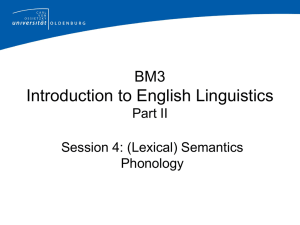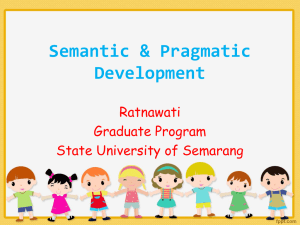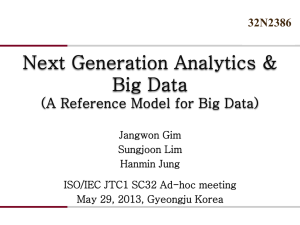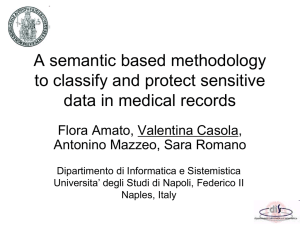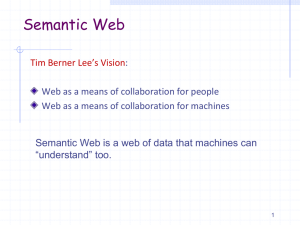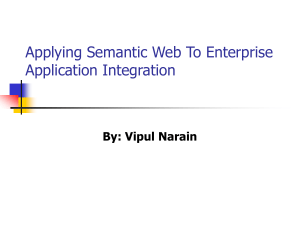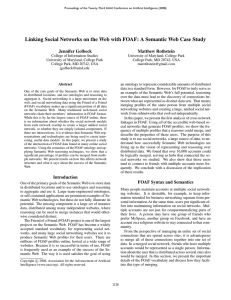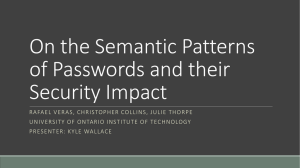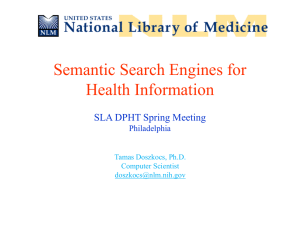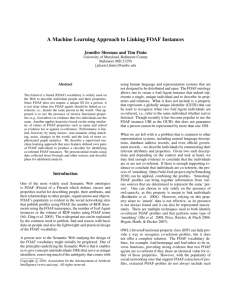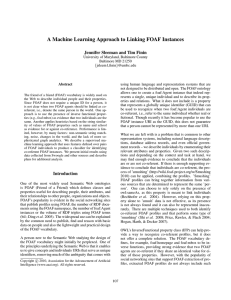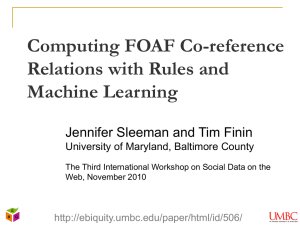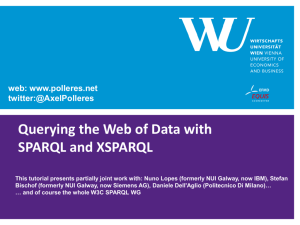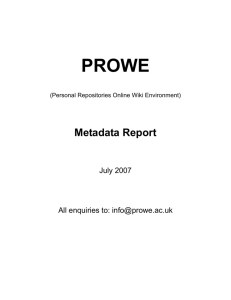A Close Look into Social Semantic Web
advertisement
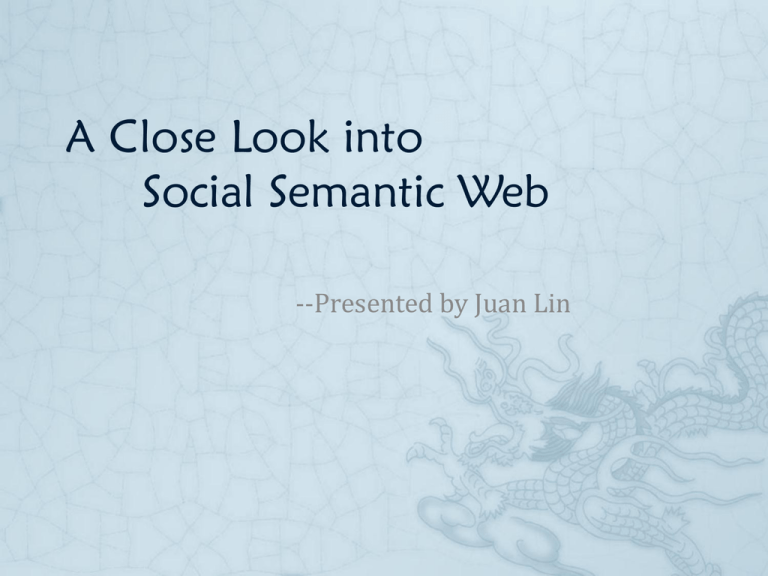
A Close Look into Social Semantic Web --Presented by Juan Lin Introduction What is Social Semantic Web Social Semantic Web applications OntoWiki SMOB filmTrust – Review Websites Future Issues The Social Web Web 2.0 : web applications enables users to interact and collaborate with each other, providing power to end-users Social Networking Sites Facebook : about 750 million users LinkedIn : around 150 million users YouTube : content-sharing sites Current Issues with Social Web Lack of interoperability Lack of efficient data exchange Reasons : 1. individual service provider wants to bind their customers 2. no common standards for all parties to exchange information When Social Web meets the Semantic Web "The Semantic Web is not a separate Web but an extension of the current one, in which information is given well-defined meaning, better enabling computers and people to work in cooperation." -- Tim Berners-Lee (2001) FOAF Friend of a Friend (FOAF), aiming at providing machine-readable contents that can be shared without the implementation of centralised databases OWL and RDF are the foundation for FOAF FOAF makes individual profiles from different social web pages into one fully detailed profile possible FOAF foaf:name, foaf:surname and foaf:firstname are used to provide information for person name properties. foaf:phone is used to describe phone number for individuals foaf:nick is used to describe user preferred nickname for themselves foaf:mbox can be used to provide Email address foaf:depiction is for providing user profile image foaf:homepage is the field for keeping the URL for person's personal home page foaf:gender is for keeping gender information. foaf:knows is a field that can be used to describe a person that current people object knows. It can be linked to another foaf:person instance. FOAF Foaf:knows has different kinds of usage; It can be used to describe two workers in the same company, but not closed friends Allow linking individuals by using foaf:person, help generate RDF nodes to build up an integrated social network graph FOAF description is saved into files and kept on the web servers, allowing public access to these personal profiles Semantic Wiki-- OntoWiki Wiki -- a type of websites, allowing users to add, modify and delete the content via web browsers; e. g. Wikipedia Current Usage for Wikis: free dictionaries, research projects/ papers OntoWiki OntoWiki: help end users with simplification of the presentation and acquisition of web data It uses “information maps” as the knowledge bases, where each node can be configured by end users and linked to other resources. It provides different ways to view information for end users, e.g., list view, map view. Assist social collaboration : changes tracking; commenting ; rating OntoWiki It also contributes to the development of semantic search and it can be transformed to be a search engine OntoWiki Mobile is available and following the HTML 5 standards, allowing users to edit and access semantic information on-the-run. Issue with OntoWiki: it is based on knowledge engineering and it treats a single case as not known or not definable. Semantic Microblogging Microblogging – a simpler form of blogging, such as Twitter, Sina Weibo It is sensitive to real-time news and events It contains a huge amount of data that provided by end users Main drawback: posts are not related to any semantic; related posts are really hard to be integrated; hard to querying and reuse information; # hashtags are not machinereadable SMOB SMOB – Semantic MicrOBlogging ; an opensource framework ; LAMP ; Goal : provide a decentralised and distributed platform for microblogs Each microblog published via SMOB is transformed into RDFa It is built on distributed hubs, no need of centralised server. Distributed hubs communicate through SPARQL SMOB ontologies stack SMOB “Interlinking components” is introduced to enable interlink microblog posts with the Linking Open Date cloud. It can suggest relevant URI for each term in # hashtags automatically; can be used in the future Auto-completion: for geography location information by integrating GeoNames ; allowing users gather related location-based information Review Websites Review websites – online service websites for individuals to post/comment/rank particular products, services, etc. Early review-enabled website: Amazon.com FilmTrust : a web-based platform allows registered users to read, rate and review movies. The goal is to utilise trust rating within the Social Web as the foundation of calculating similaries. FilmTrust Users can add other persons as friends, but can be one-way action. Users rank their friends as “how likely you would see the film which is picked by this friend” “Recommended Rating” uses the inferred trust values to compute with TidalTrust, to calculate a weighted average rating for each movie. It is an example of collaborative filtering system Future Issues for the Social Semantic Web Privacy on the usage of Social Semantic Web Personal authentication and authorization issue How does individual authenticate themselves across a linked data web Related information disclosure access control is a necessity to protect individual’s privacy Data Collection Issue Semantic search might require record users’ activity history -- might violate users' privacy Future Issues cont. Effective semantic search on the Semantic Web Information overload Lack of information availability ( required data not shown up to the querying users) Navigation problem (feeling lost in hyperspace) Ignorance of user diversity How machine can understand the context of “terms”, e.g. different meanings for “Beetle” Conclusion Social Semantic Web will be playing an important role in Web 3.0 We need to carefully balance the pros and cons that Social Semantic Web brings up References S.Auer, S. Dietzold and T. Riechaer , "OntoWiki- A Tool for Social Semantic Collaboration", 5th International Semantic Web Conference, ISWC2006, http://www.springerlink.com/content/e0081w7457683855/ J.Banford, A. McDiarmid, and J. Irvine," FOAF: improving detected social network accuray", UbiComp (Adjunct Papers) 2010: 393-394. http://dl.acm.org/citation.cfm?id=1864453 J. Golbeck and M. Rothstein, "Linking Social Networks on the Web with FOAF: A Semantic Web Case Study", AAAI Press, p. 1138-1143, 2008. https://www.aaai.org/Papers/AAAI/2008/AAAI08-180.pdf J. Hendler and T. Berners-Lee, ―From the Semantic Web to social machines: A research challenge for AI on the World Wide Web", Artif. Intell., 174, (2), 156-161,2010. http://www.stanford.edu/class/cs227/Readings/hendler-berners-lee-semantic-web.pdf A. Passant, T. Hastrup, U. Bojars and J. Breslin, "Microblogging: A Semantic and Distributed Approach", The 4th Workshop on Scripting for the Semantic Web (SFSW 2008) at the 5th European Semantic Web Conference (ESWC '08), Tenerife, Spain, 2008. http://aran.library.nuigalway.ie/xmlui/bitstream/handle/10379/539/11.pdf?sequence=1 Sami I Makelainen, "Social Semantic Web", in Proc. ECOC’00, 2000, paper 11.3.4, p. 109. http://www.groundswell.fi/sim/academic/SocialSemanticWeb.pdf
